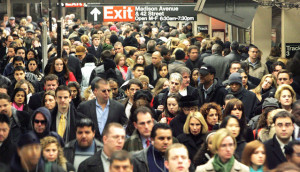Migration driving urban change – IOM report
Migration is shaping the world’s great cities like never before with three million extra people moving to dense urban areas every week, a new report says.
And with nearly one in five of the population of the globe’s big cities now foreign-born, the need for migration and how it is governed to be an issue at the frontline of urban planning and sustainable development has never been more critical.
The ‘World Migration Report 2015: Migrants and Cities, New Partnerships to Manage Mobility’, produced by the International Organisation for Migration (IOM), focuses on migrants and how migration is shaping cities and the situation of migrants in cities.
The report highlights how cities and migrants can work together in order to reduce the risks of migration to cities and take advantage of growing urban diversity in such areas as community resilience building and local economic, social and cultural development through migrants’ connections between origin and host communities.
The report found that more than 54 per cent of people across the globe were living in urban areas in 2014. The current urban population of 3.9 billion is expected to grow in the next few decades to some 6.4 billion by 2050.
In many of these cities such as Sydney, Melbourne, London, and New York, migrants represent over a third of the population and, in some cities such as Brussels and Dubai, migrants account for more than half of the population.
Other cities have seen a remarkable growth in migration in recent years. For example, the number of foreign residents in Seoul has doubled in the last ten years.
In Asia and Africa, rapidly growing small cities are expected to absorb almost all the future urban population growth of the world.
The report said there were now an estimated 232 million international migrants and 740 million internal migrants in the world.
“Migration, and how it is governed, should be an issue at the frontline of urban planning and sustainable development. However, migration is largely omitted from the global debate on urbanization,” the report says.
“There is a glaring absence of the mention of migrants in international planning for a new global urban agenda. Many city and local governments also still do not include migration or migrants in their urban development planning and implementation. Migrants are therefore still generally overlooked in global discourses on urbanization,” the report says.
It is said we are living in an era of unprecedented human mobility that has been markedly urban as migrants, both internal and international, move to cities and urban areas, bringing diversity and connecting communities within and across borders to create new linkages among localities.
“This calls for new approaches to urban governance and migration policies,” the report said.
There are an estimated 232 million international migrants and 740 million internal migrants in the world.
The report also found:
- About 50 per cent of international migrants reside in ten highly urbanized, high-income countries5 such as Australia, Canada and the United States, several countries in Europe (France, Germany, Spain and the United Kingdom).
- Almost all growth in the world’s population over the next few decades of another 2.5 billion is expected to be in urban areas in low- and middle-income countries, particularly in Africa and Asia.
- Although Africa is not the world’s fastest urbanizing region, its urban population has been growing at a historically unprecedented rate for decades.
- Every day an estimated 120,000 people are migrating to cities in the Asia-Pacific region and, by 2050, the proportion of people living in urban areas is likely to rise to 63 per cent. The Asia–Pacific region has added nearly 1 billion people to its urban population between 1990 and 2014, about half of whom live in China alone (450 million).
The report says the geography of migration flows is changing in line with changes in the global economy.
“A much wider range of cities around the world have become destinations for migrants. For example, migrants are increasingly attracted to countries experiencing higher economic growth in East Asia, Brazil, southern Africa and western India,” it says.
“Cities everywhere are experiencing a constant ebb and flow of people between urban, regional, national and global communities. Thus cities face growing challenges of managing migration-induced diversity.
“However, at the global level, migration policies and urbanization policies tend to be discussed in separate forums, which results in a lack of policy coherence. At the national level, with very few exceptions, there is a disjuncture between national and local policies. National governments may encourage migration to urban areas for economic development without sufficient coordination with local governments on the basic social service needs on the ground,” the report says.
Speaking at the report’s launch, editor-in-chief Dr. June Lee, the report’s editor-in-chief, said that while much of the current international discussion about migration trends and policy is at national level, the report takes the migration debate to the city level.
“The report focuses on how migration is shaping cities and how the situation of migrants in cities – how they live, work and shape their habitat – helps to reveal the close connection between human mobility and urban development,” she said.
“Migration is driving much of the increase in urbanization, making cities much more diverse places in which to live,” she said.
She said a key finding of the report is that human mobility is growing and will continue to be overwhelmingly urban.
Skye Doyle
AMES Australia Staff Writer













